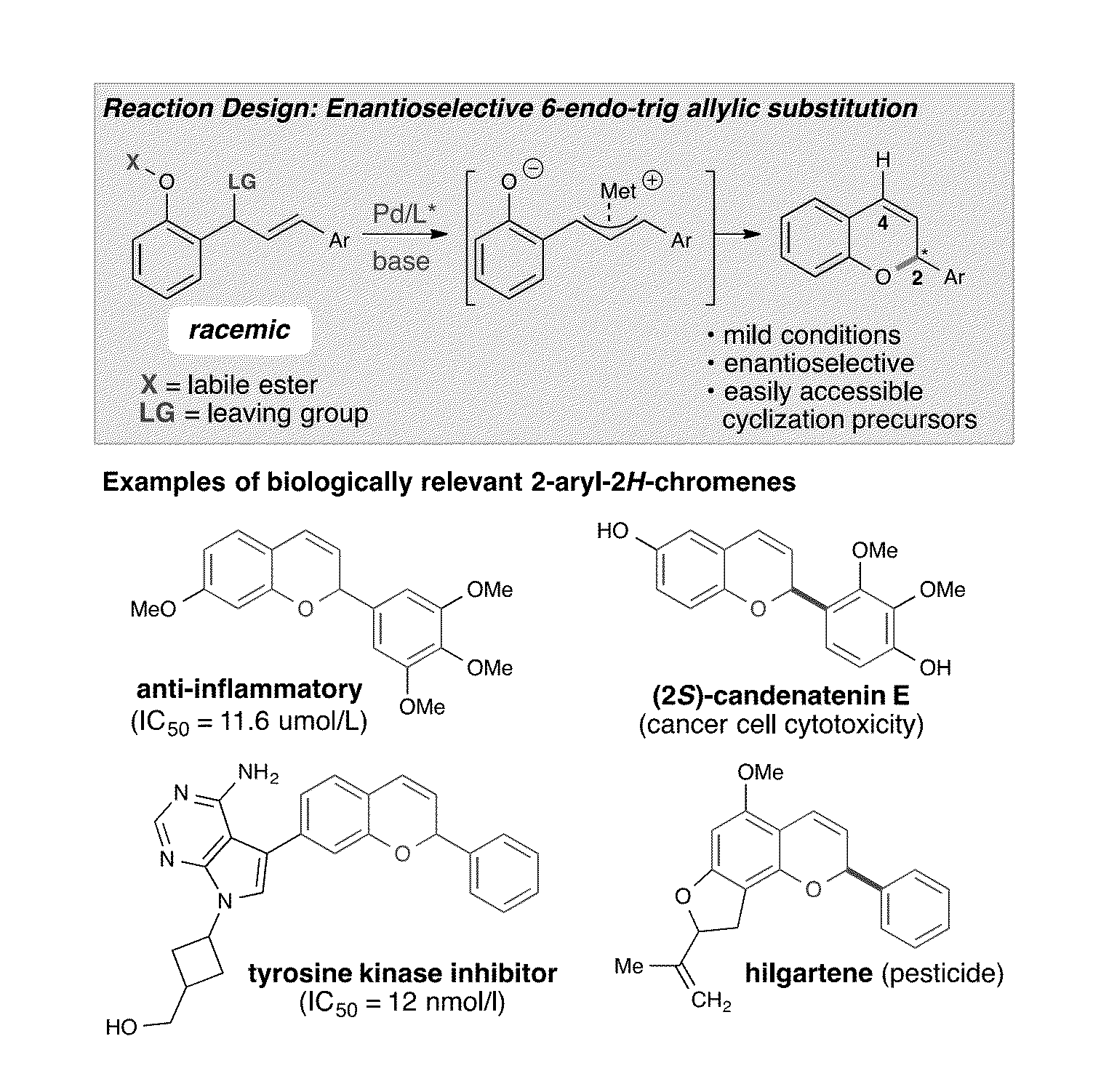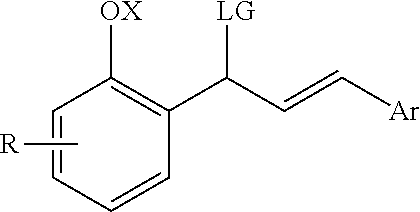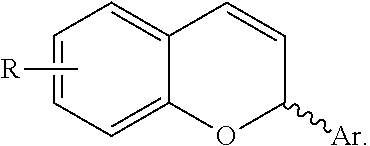Catalytic enantioselective synthesis of 2-aryl chromenes and related phosphoramidite ligands and catalyst compounds
a technology of phosphoramidite ligands and catalyst compounds, which is applied in the direction of group 5/15 element organic compounds, organic chemistry, chemistry apparatus and processes, etc., can solve the problems of insufficient documentation of the strategy for producing enantioselective variants and the difficulty of generating enantioselective variants, and achieve the effect of reducing undue concern over unwanted side reactions
- Summary
- Abstract
- Description
- Claims
- Application Information
AI Technical Summary
Benefits of technology
Problems solved by technology
Method used
Image
Examples
example 1
General Procedure for the Synthesis of 2′-Hydroxychalcone Derivatives
[0048]
[0049]2′-Hydroxychalcones were prepared using a modified literature procedure. (L. D. Chiaradia, A. Mascarello, M. Purificacao, J. Vernal, M. N. S. Cordeiro, M. E. Zenteno, A. Villarino, R. J. Nunes, R. A. Yunes, and H. Terenzi, Bioorg. Med. Chem. Lett., 2008, 18, 6227-6230.) Into a round bottom flask equipped with magnetic stirring bar was dissolved acetophenone derivative (15 mmol, 1 equiv) in methanol (100 mL) and 50% w / v KOH (17 mL). The reaction was stirred at 0° C. for 30 min. The aldehyde (18 mmol, 1.2 equiv) was added in one portion, and the mixture was stirred at 23° C. for 12-24 h. The solution was neutralized with 12 M HCl. The precipitate was removed by vacuum filtration, washed with water, dried, and recrystallized from methanol or dichloromethane / hexanes. When no precipitate was formed upon neutralization, the solution was extracted with EtOAc, and the combined organics were dried over sodium su...
example 2
General Procedure for the Synthesis of Bis-Acetates
[0050]
[0051]Into a round bottom flask equipped with magnetic stir bar was loaded 2′-hydroxychalcone derivative (2.5 mmol, 1 equiv), CeCl3.7H2O (5.5 mmol, 2.2 equiv), ethanol (200 proof, 8.8 equiv), and THF (0.1 M 25 mL). The mixture was cooled to 0° C. before NaBH4 (5.5 mmol, 2.2 equiv) was added in one portion and allowed to slowly warmed to 23° C. Upon consumption of the 2′-hydroxychalcone, 4-dimethylaminopyridine (3.75 mmol, 1.5 equiv), pyridine (37.5 mmol, 15 equiv), and acetic anhydride (37.5 mmol, 15 equiv) were successively added. The reaction was stirred for 12-18 h and concentrated. The unpurified residue was taken up in EtOAc and quenched with a saturated solution of sodium bicarbonate. The layers were separated and the aqueous layer was back extracted with EtOAc. The combined organics were washed with DI H2O, saturated copper(II) sulfate, and brine, dried over sodium sulfate, filtered, and concentrated under reduced press...
example 3
[0052]
[0053](E)-1-(2-Acetoxy-3-methylphenyl)-3-phenylallyl acetate (1a). Prepared according to the general procedure using (E)-2-(1-hydroxy-3-phenylallyl)-phenol. The residue was purified by flash chromatography using 15% EtOAc / hexanes to afford 1a as a clear crystal (450 mg, 74%). Analytical data for 1a: 1H NMR (500 MHz, CDCl3) δ 7.52 (dt, J=7.7, 1.5 Hz, 1H), 7.39-7.34 (m, 3H), 7.35-7.23 (m, 4H), 7.11 (dt, J=8.1, 1.3 Hz, 1H), 6.62 (d, J=16.0, 1H), 6.61 (d, J=6.5 Hz, 1H), 6.35 (dd, J=15.8, 6.6 Hz, 1H), 2.32 (s, 3H), 2.11 (s, 3H); 13C NMR (125 MHz, CDCl3) δ 170.0, 169.5, 148.4, 136.2, 132.9, 131.1, 129.5, 128.7, 128.6, 128.3, 126.8, 126.5, 126.2, 123.3, 71.3, 21.3, 21.2; IR (film): 3061, 3027, 2938, 1765, 1738, 1650, 1586, 1491, 1452, 1369, 1233, 1197, 1173, 1098, 1063, 1015, 964, 911, 877 cm−1; LRMS (ESI): Mass calculated for [M+H]+ C19H19O4: 311.1; found: 311.1.
PUM
| Property | Measurement | Unit |
|---|---|---|
| pH | aaaaa | aaaaa |
| 1H NMR | aaaaa | aaaaa |
| HPLC | aaaaa | aaaaa |
Abstract
Description
Claims
Application Information
 Login to View More
Login to View More - R&D
- Intellectual Property
- Life Sciences
- Materials
- Tech Scout
- Unparalleled Data Quality
- Higher Quality Content
- 60% Fewer Hallucinations
Browse by: Latest US Patents, China's latest patents, Technical Efficacy Thesaurus, Application Domain, Technology Topic, Popular Technical Reports.
© 2025 PatSnap. All rights reserved.Legal|Privacy policy|Modern Slavery Act Transparency Statement|Sitemap|About US| Contact US: help@patsnap.com



